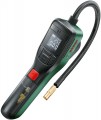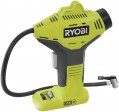Pressure gauge
The type of built-in pressure gauge incorporated into the pump/compressor design. Modern pressure gauges differ mainly in the type of scale on which readings are displayed:
—
Analogue. A classic pressure gauge equipped with an analogue scale — a round “dial” with an arrow. Such devices are extremely simple and inexpensive, moreover, they are completely autonomous, do not require a power source and can be used in hand and foot devices. However, they are noticeably inferior to digital ones in accuracy: the scale is capable of displaying readings at best with an accuracy of a tenth of an atmosphere, (sometimes up to two tenths or even more), besides, the arrow tends to vibrate when pumped, which makes it difficult to determine the readings. On the other hand, such accuracy in fact is often quite enough, so analogue pressure gauges have been and remain the most popular option.
—
Digital. Pressure gauges equipped with an electronic display that shows pressure data. Such devices have high measurement accuracy — often up to hundredths of an atmosphere (or equivalent in other units), besides, they can provide various additional features — for example, hitchhiking (see below) or switching between measurement in atmospheres and and in pounds per inch2. At the same time, digital pressure gauges are much more expensive than analogue ones, the mentioned accuracy is rarely required in fact, and the
...electronics require a power source, which makes it difficult to use in non-electric pumps (batteries would be required, and they have a limited operating time). As a result, this variant has not received much distribution.
— Is absent. There are quite a few pumps and compressors that do not have a pressure gauge at all. On the one hand, this does not allow you to monitor the pressure during the inflation process: you have to control the condition of the tyre “by eye”, and to measure the pressure, disconnect the unit and use a separate pressure gauge. On the other hand, such models turn out to be more compact and inexpensive than similar solutions with pressure gauges, and the described pumping procedure, although associated with unnecessary hassle, is generally not particularly complicated and does not present any particular difficulties even for inexperienced drivers.Max. pressure
The maximum pressure provided by the pump or compressor — in other words, the highest tyre pressure that can be achieved using this unit.
In most models, this figure is
from 2.5 to 10 atm, and in mechanical pumps (manual and foot, see "Type") pressure of more than 10 atm is practically not found at all. This is due to the fact that even for heavy trucks, the optimal tyre pressure is usually about 5 – 9 atm (depending on a number of parameters — there are special formulas and tables for calculations); and in passenger car tyres, a pressure of more than 2.5 atm is extremely rarely used. However, there are compressors with higher pressure parameters —
11 – 15 atm,
16 – 20 atm and even
higher. The meaning of such characteristics is mainly in the "power reserve": a higher working pressure contributes to faster pumping. However, be careful not to over-inflate the tyre and damage it.
Performance
The capacity of the compressor (see "Type") is the maximum amount of air that it can pump into the tyre in a minute.
Higher performance reduces the time required to inflate the wheel; on the other hand, this parameter directly affects the dimensions, weight, power consumption and price of the compressor. So it is worth choosing according to performance, taking into account real needs. So, for a “duty” tyre inflation in a passenger car, a compressor with a low operating speed is quite enough — up to
20 L / min inclusive. And if the speed of full pumping is also important for you (for example, after replacing the rubber) — you can choose a unit for
21 – 40 L / min. In turn, models with more solid characteristics —
41 – 60 L / min and
more — are intended mainly for heavy equipment like SUVs, trucks, tractors, etc.
Separately, it should be noted that this parameter is NOT suitable for calculating the exact inflation time (even if the exact volume of air in the wheel is known). The fact is that the actual performance of the compressor is always lower than the claimed one: the figures in the characteristics are indicated for free air outlet, and when pumping the wheels, the pumping speed will inevitably be lower due to the resistance of the nipple.
Hose length
The length of the hose through which air is pumped into the tyre. The larger it is, the more convenient the device is to use. But it is rare that the compressor is left far from the wheel, especially if a pressure gauge is placed on the device, which must be periodically checked. For domestic use in cars, a one and a half metre long hose is enough. Powerful and performant models can be equipped with a hose of 7 metres or more, but these are more solutions for commercial use in car services.
Battery in set
The presence or absence
of a battery supplied with the corresponding compressor. This item may also indicate a built-in battery.
Models with a removable battery are usually produced for a specific battery platform (see the corresponding paragraph). The advantage of this solution is obvious: first of all, it allows you to use the same battery both to operate the compressor and for another power tool supporting a similar battery platform. For normal full operation of the device right out of the box, 1 battery is enough. The option without a battery becomes relevant if the customer wants to choose a power source separately, or when such a source is already on the household.
Many compressors are equipped with a built-in battery. This design saves the customer from fiddling with a separate charger, but does not allow you to quickly replace a dead battery with a fresh one - the only option is charging, which requires a power source and takes some time. However, models with a built-in battery are often more compact, which benefits them exclusively for future use.
Battery platform
The name of the battery platform supported by the device. A single battery platform is used to combine various power tools of the same brand (screwdriver, grinder, circular saw, etc.) into one line. Devices belonging to the same platform use interchangeable batteries and chargers. Thanks to this, for example, there is no need to select a battery for each individual model, because one battery purchased as a spare can be used in various power tools, depending on the situation or as needed. Batteries of the same platform mainly differ from each other except in capacity.
Battery voltage
The nominal battery voltage for which the cordless tool is designed.
Manufacturers select battery voltage taking into account the operating characteristics and the power supply required to achieve these characteristics. In practice, this means that most often you can not pay attention to this parameter at all when choosing. The only exceptions are some specific situations - for example, if the “household” already has a battery from the same company and you want to evaluate its compatibility with the selected model, if the selected tool comes without a battery and you want to immediately order a power source for it, or for accurate comparison of batteries by capacity. But after purchase, voltage data can also be useful for searching for chargers in addition to or as a replacement for the “native” charger.
Battery capacity
In theory, the higher the capacity, the longer a cordless tool can last on a single battery charge. However, in practice, everything is far from so simple. Firstly, ampere-hours are a fairly specific unit; its features are such that only batteries with the same voltage can be directly compared by the number of ampere-hours. If there is a difference in voltage, you need to convert the capacity into watt hours and use them for comparison. Secondly, the actual autonomy of the tool depends not only on the properties of the battery, but also on power consumption and other performance characteristics. Thus, it is possible to compare different models in terms of battery capacity only with the same supply voltage and similar capabilities.
Compatible batteries
Models of batteries compatible with the device.
When choosing a tool, this information is relevant mainly for models without a battery included. For devices supplied with batteries, the battery model is more of a reference value - it is indicated mainly “for the future” if a spare or replacement battery is needed. However, this data can also be useful during the selection process - for example, to assess compatibility with a battery you already have on your household, or to find detailed data on compatible batteries and determine how well they meet your requirements.

